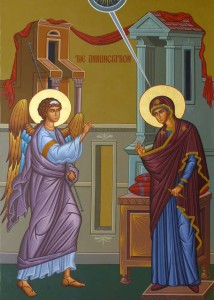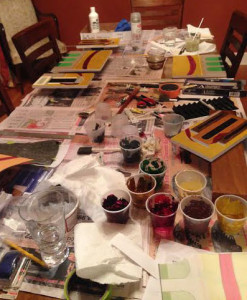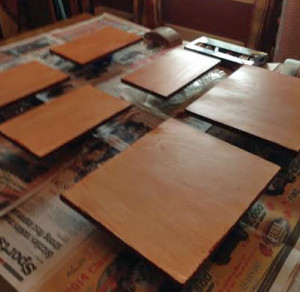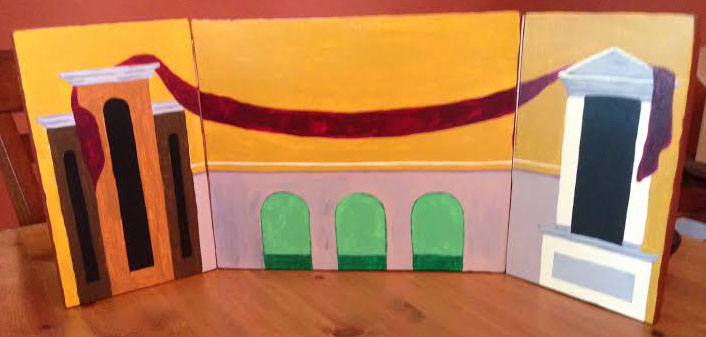
My friend (and Goddaughter) Sue and I worked together on an art project this week. Sue is an excellent artist, with a degree in fine arts and then ongoing training in the realist school. She does portraits and landscapes in oil. On the other hand, I have no formal art training, but I did study, practice and teach iconography for several years. So when we volunteered to paint the background on icon boards for the new church school curriculum at St. John Orthodox Church, we envisioned a fairly easy project. What we didn’t see coming (or at least I didn’t) was the lessons we would learn as we worked almost non-stop for almost seven hours on Wednesday. And as I continued for another three hours on Thursday. And this was after we had gessoed and sanded the six icon boards before getting together to paint.

Our parish is implementing a new curriculum based on the international Montessori-inspired program, The Catechesis of the Good Shepherd. A group of Orthodox women have adapted the program for our church school needs and are beginning to introduce it in numerous parishes, including ours here in Memphis. I didn’t know much about the program when I volunteered to help shop for materials this past summer, and later to help with painting the icon boards. Sue and I were given patterns to use on the boards (which will form two triptychs after someone else puts them together with fasteners) and acrylic paints.
The subject is the icon of the Annunciation—the scene where Archangel Gabriel announces to Mary that she is going to bear Jesus. Another parishioner is making figurines of Mary, the Mother of God, and the Archangel Gabriel, which the children will use with the backgrounds. (Click here for a description of the scene depicted in the icon.)
 So, as we transferred the patterns and began to paint, Sue and I both experienced some frustration. Neither of us have used acrylics extensively—I’ve used mainly egg tempera and watercolor and Sue works primarily with oils. As the project stretched into the afternoon and evening, we both got tired and began to be critical of our own work. We tried to remember that these are not actual icons to be used in a church, but materials to be used by children in a church school program. But we still wanted them to be done well.
So, as we transferred the patterns and began to paint, Sue and I both experienced some frustration. Neither of us have used acrylics extensively—I’ve used mainly egg tempera and watercolor and Sue works primarily with oils. As the project stretched into the afternoon and evening, we both got tired and began to be critical of our own work. We tried to remember that these are not actual icons to be used in a church, but materials to be used by children in a church school program. But we still wanted them to be done well.
What I wish I had read before we began the work was this list of characteristics of the Catechesis of the Good Shepherd, or “32 Points of Reflection,” many of which address the attitude of the people preparing to teach the classes, and of those who are preparing materials. I was especially struck by Number 18:
The material must be attractive but “sober” and must strictly adhere to the theme being presented. In making the material, the catechist refrains from adding superficial embellishments which would distract the child from the essentials of the theme being presented. In other words, the material must be simple, essential and “poor” in order to allow the richness of the themes content to shine through.

Simple. Essential. And poor. I immediately thought about one of the verses of the Beatitudes, “Blessed are the poor in spirit.” It’s about humility—not only the humility the teachers should have, but also those of us preparing the materials to be used.
I thought about how Sue and I considered adding some highlights to some of the elements of the images we were painting because we thought they looked too “plain.” We didn’t end up embellishing them very much, and now I’m really glad, as I can see how the design was intentional. At one point I was ahead of Sue (we were each painting the same designs) and took a break to cook supper. As I got tired, I began to hurry the process, whereas Sue took her time and was more careful with the work. Later I read the 25th Point of Reflection and realized the value of Sue’s approach:
The reasons why the catechist is requested to make the materials with his/her own hands are:
-
to absorb the content more deeply;
-
to combat hurry, consumerism and even excessive “efficiency”;
-
to pace oneself more to the rhythm of the child and thus also – or so we believe – to the working of the Holy Spirit;
-
to try to reach the integration of hand, mind and heart.

Again, Sue and I aren’t catechists (teachers) but even our limited participation in the program will be enhanced if we follow these reflections. And what great reminders of how we should approach all of life—combating hurry, consumerism and excessive “efficiency.” I’m not training to be a “catechist” (teacher) in this new program, but I’m excited that it’s being implemented in our parish. I wish it had been around when my children were young. (One of the teachers was a student in the 6th and 7th grade class I taught over fifteen years ago!) I’m also encouraged by the philosophy and approach that reaches beyond the classroom into the lives of others in the parish. Like me. I am changed by my participation in this one simple project, and I hope to have the opportunity to be involved more in the future. Maybe I will at least struggle against my tendency towards “excessive efficiency.”

These look great, Susan! We have the COTGS at our church, too. I wasn’t sure about it at first, but my kids enjoy it, and it’s amazing how much they learn. I’m so glad you’re involved.
Our teachers were just in Nashville training with some of the women at St. Ignatius this week, Karissa. I’m glad your kids enjoy it.
Thank you for this article Ma’am.
I have been pondering this hasty life we are ‘forced’ to live at times.
For myself and for others I care about.
I keep wondering where we are all going in such a hurry?!
I know this is not the be all and end all’ of what you express in this write…yet it really speaks to me about a strong feeling I have at the moment to set aside some things I am doing to take more time to slow down and do things that will require me to focus more closely on getting deeper into ‘the integration of hand mind and heart’. I often get this with writing…but for me my special place to get it is with my painting. I have neglected this for a while and was teetering again (as I have for many many years) between the writing and the art. I know I CAN do both and should likely (though time is a problem that pushes us to try be SO EFFICIENT! 🙁 ) but I was trying to figure out if I was ‘giving up’ – or stepping back from writing and the hurried social media/blog building life by wanting to set it aside a bit and get drawn into my art… or if I was being convicted to do so.
Oddly – this is the second thing today that makes me feel convicted. JUST earlier today I was ‘talking’ (via email) to a dear friend about them needing to disengage and slow down. They thrive on being efficient and BUSY at their dreams, but it can take its toll I think. While I was writing to them it made me feel so many direct relations to my own life at the moment too (and in the past a bit)
Any way – short story made long!
Thank you – your words are encouraging.
Belinda… wow. I love how different things speak to different people… and yes, the “integration of hand, mind and heart” can so easily get lost today. Even the process of writing, which I used to do with pen and paper, can seem rushed with computers, can’t it? Thanks for reading and sharing your thoughts.
It really can – I find I get hyped UP rather than smooth and grounded. Really it just makes sense that that should happen when typing instead of hand writing…but we seldom think of it. The whole process is so different I am sure. Hand writing requires a small motion of the hand in a smooth and rhythmic (soothing) motion, whereas the keyboard is aiming at stuff!! (for me anyway)
I imagine it IS or can be different for different folk, I have heard folk speak of the soothing sound of the tap of the keyboard – so perhaps they find it that connection they need to have. I know I STILL get ‘entranced’ when I type…but… I write FAR too much in a small amount of time and it is almost like it is too easy to delete and redo, so we JUST GO AT IT.
But a pen… I MAY have forgotten how to hold one 😉
I THINK the keyboard HAS advantages for a very fast paced mind…but IS that always the point of writing. I THINK it is also about ‘slowing things down’ when they get too fast.
Then again… the keyboard HAS given me more room to explore words and ideas in an ‘easier’ way due to the ability to rehash, re-space, copy paste etc. (great for poetry when it is just pouring out and you do not want to ‘forget it’ !)
I think…I just went around in a big circle there. Haha.
I guess we need to learn how to use both ways in a nice balanced way?
Have a good weekend Ma’am.